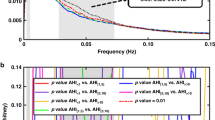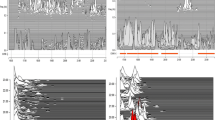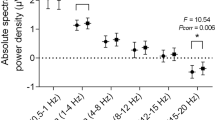Abstract
Purpose
Several studies have correlated the ratio of the very low frequency power spectral density of heart rate increment (%VLFI) with obstructive sleep apnoea syndrome (OSAS). However, patients with impaired heart rate variability may exhibit large variations of heart rate increment (HRI) spectral pattern and alter the screening accuracy of the method.
Methods
To overcome this limitation, the present study uses the high-frequency increment (HFI) peak in the HRI spectrum, which corresponds to the respiratory influence on RR variations over the frequency range 0.2 to 0.4 Hz. We evaluated 288 consecutive patients referred for snoring, observed nocturnal breathing cessation and/or daytime sleepiness. Patients were classified as OSAS if their apnoea plus hypopnoea index (AHI) during polysomnography exceeded 15 events per hour. Synchronized electrocardiogram Holter monitoring allowed HRI analysis.
Results
Using a %VLFI threshold >2.4% for identifying the presence of OSAS, sensitivity for OSAS was 74.9%, specificity 51%, positive predictive value 54.9% and negative predictive value 71.7% (33 false negative subjects). Using threshold for %VLFI >2.4% and HFI peak position >0.4 Hz, negative predictive value increased to 78.2% while maintaining specificity at 50.6%. Among 11 subjects with %VLFI <2.4% and HFI peak >0.4 Hz, nine demonstrated moderate to severe OSAS (AHI >30).
Conclusions
HFI represents a minimal physiological criterion for applying %VLFI by ensuring that heart rate variations are band frequency limited.


Similar content being viewed by others
References
Young T, Palta M, Dempsey J, Skatrud J, Weber S, Badr S (1993) The occurrence of sleep-disordered breathing among middle-aged adults. N Engl J Med 328:1230–1235
Olson LG, King MT, Hensley MJ, Saunders NA (1995) A community study of snoring and sleep-disordered breathing: prevalence. Am J Respir Crit Care Med 152:711–716
Roux F, D’Ambrosio C, Mohsenin V (2000) Sleep-related breathing disorders and cardiovascular disease. Am J Med 108:396–402
Shahar E, Whitney CW, Redline S, Lee ET, Newman AB, Javier Nieto F, O’Connor GT, Boland LL, Schwartz JE, Samet JM (2001) Sleep-disordered breathing and cardiovascular disease: cross-sectional results of the Sleep Heart Health Study. Am J Respir Crit Care Med 163:19–25
Yaggi HK, Concato J, Kernan WN, Lichtman JH, Brass LM, Mohsenin V (2005) Obstructive sleep apnea as a risk factor for stroke and death. N Engl J Med 353:2034–2041
Marin JM, Carrizo SJ, Vicente E, Agusti AG (2005) Long-term cardiovascular outcomes in men with obstructive sleep apnoea–hypopnoea with or without treatment with continuous positive airway pressure: an observational study. Lancet 365:1046–1053
Reeder MK, Muir AD, Foex P, Goldman MD, Loh L, Smart D (1991) Postoperative myocardial ischaemia: temporal association with nocturnal hypoxaemia. Br J Anaesth 67:626–631
McNicholas WT, Bonsigore MR (2007) Sleep apnoea as an independent risk factor for cardiovascular disease: current evidence, basic mechanisms and research priorities. Eur Respir J 29:156–178
Chami HA, Devereux RB, Gottdiener JS, Mehra R, Roman MJ, Benjamin EJ, Gottlieb DJ (2008) Left ventricular morphology and systolic function in sleep-disordered breathing: the Sleep Heart Health Study. Circulation 117:2599–2607
Kiely JL, McNicholas WT (2000) Cardiovascular risk factors in patients with obstructive sleep apnoea syndrome. Eur Respir J 16:128–133
Peker Y, Hedner J, Norum J, Kraiczi H, Carlson J (2002) Increased incidence of cardiovascular disease in middle-aged men with obstructive sleep apnea: a 7-year follow-up. Am J Respir Crit Care Med 166:159–165
Guilleminault C, Connolly S, Winkle R, Melvin K (1984) Cyclical variation of the heart rate in sleep apnoea syndrome. Mechanisms, and usefulness of 24 h electrocardiography as a screening technique. Lancet 1:126–131
Hedner J, Ejnell H, Sellgren J, Hedner T, Wallin G (1988) Is high and fluctuating muscle nerve sympathetic activity in the sleep apnea syndrome of pathogenetic importance for the development of hypertension? J Hypertens 6:S529–S531
Wiklund U, Olofsson BO, Franklin K, Blom H, Bjerle P, Niklasson U (2000) Autonomic cardiovascular regulation in patients with obstructive sleep apnoea: a study based on spectral analysis of heart rate variability. Clin Physiol 20:234–241
Kitney RI (1980) An analysis of the thermoregulatory influences on heart-rate variability. In: Kitney RI, Rompelman O (eds) The study of heart rate variability. Clarendon Press, Oxford, p 37
Taylor JA, Carr DL, Myers CW, Eckberg DL (1999) Mechanisms underlying very-low frequency RR-interval oscillations in humans. Circulation 98:547–555
Ichimaru Y, Yanaga T (1989) Frequency characteristics of the heart rate variability produced by Cheyne–Stokes respiration during 24-hour ambulatory electrocardiographic monitoring. Comput Biomed Res 22:225–233
Mortara A, Sleight P, Pinna GD, Maestri R, Prpa A, La Rovere MT, Cobelli F, Tavazzi L (1997) Abnormal awake respiratory patterns are common in chronic heart failure and may prevent evaluation of autonomic tone by measures of heart rate variability. Circulation 96:246–252
Malconian M, Hultgren H, Nitta M, Anholm J, Houston C, Fails H (1990) The sleep electrocardiogram at extreme altitudes (Operation Everest II). Am J Cardiol 65:1014–1020
Shiomi T, Guilleminault C, Sasanabe R, Hirota I, Maekawa M, Kobayashi T (1996) Augmented very low frequency component of heart rate variability during obstructive sleep apnea. Sleep 19:370–377
Ponikowski P, Chua TP, Piepoli M, Amadi AA, Harrington D, Webb-Peploe K, Volterrani M, Colombo R, Mazzuero G, Giordano A, Coats AJ (1997) Chemoreceptor dependence of very low frequency rhythms in advanced chronic heart failure. Am J Physiol 272:H438–447
Ponikowski P, Anker SD, Chua TP, Francis D, Banasiak W, Poole-Wilson PA, Coats AJ, Piepoli M (1999) Oscillatory breathing patterns during wakefulness in patients with chronic heart failure: clinical implications and role of augmented peripheral chemosensitivity. Circulation 100:2418–2424
Roche F, Duverney D, Court-Fortune I, Pichot V, Costes F, Lacour JR, Antoniadis JA, Gaspoz JM, Barthelemy JC (2002) Cardiac interbeat interval increment for the identification of obstructive sleep apnea. Pacing Clin Electrophysiol 25:1192–1199
Roche F, Sforza E, Duverney D, Borderies JR, Pichot V, Bigaignon O, Ascher G, Barthélémy JC (2004) Heart rate increment: an electrocardiological approach for the early detection of obstructive sleep apnoea/hypopnoea syndrome. Clin Sci (Lond) 107:105–110
Vazir A, Dayer M, Hastings PC, McIntyre HF, Henein MY, Poole-Wilson PA, Cowie MR, Morrell MJ, Simonds AK (2006) Can heart rate variation rule out sleep-disordered breathing in heart failure? Eur Respir J 27:571–577
Damy T, D’Ortho MP, Estrugo B, Margarit L, Mouillet G, Mahfoud M, Roudot-Thoraval F, Vermes E, Hittinger L, Roche F, Macquin-Mavier I (2009) Heart rate increment analysis is not effective for sleep-disordered breathing screening in patients with chronic heart failure. J Sleep Res 19:131–138
The Report of an American Academy of Sleep Medicine Task Force (1999) Sleep-related breathing disorders in adults: recommendations for syndrome definition and measurement techniques in clinical research. Sleep 22:667–689
A manual of standardized terminology, techniques and scoring system for sleep stages of human subjects. In: Rechtschaffen A, Kales A (eds) UCLA Brain Information Services/Brain Research Institute, Los Angeles, USA, 1968
Nelder JA, Mead R (1965) A simplex method for function minimization. Comput J 7:308–313
Sforza E, Pichot V, Cervena K, Barthelemy JC, Roche F (2007) Cardiac variability and heart-rate increment as a marker of sleep fragmentation in patients with a sleep disorder: a preliminary study. Sleep 30:43–51
Narkiewicz K, Montano N, Cogliati C, van de Borne PJ, Dyken ME, Somers VK (1998) Altered cardiovascular variability in obstructive sleep apnea. Circulation 98:1071–1077
Carlson JT, Hedner JA, Sellgren J, Elam M, Wallin BG (1996) Depressed baroreflex sensitivity in patients with obstructive sleep apnea. Am J Respir Crit Care Med 154:1490–1496
Parati G, Dirienzo M, Bonsignore MR, Insalaco G, Marrone O, Castiglioni P, Bonsignore G, Mancia G (1997) Autonomic cardiac regulation in obstructive sleep apnea syndrome: evidence from spontaneous baroreflex analysis during sleep. J Hypertens 15:1621–1626
Ryan S, Ward S, Heneghan C, McNicholas WT (2007) Predictors of decreased spontaneous baroreflex sensitivity in obstructive sleep apnea syndrome. Chest 131:1100–1107
Heneghan C, Chua CP, Garvey JF, de Chazal P, Shouldice R, Boyle P, McNicholas WT (2008) A portable automated assessment tool for sleep apnea using a combined Holteroximeter. Sleep 31:1432–1439
Heneghan C, de Chazal P, Ryan S, Chua CP, Doherty L, Boyle P, Nolan P, McNicholas WT (2008) Electrocardiogram recording as a screening tool for sleep disordered breathing. J Clin Sleep Med 4:223–228
Pépin JL, Defaye P, Vincent E, Christophle-Boulard S, Tamisier R, Lévy P (2009) Sleep apnea diagnosis using an ECG Holter device including a nasal pressure (NP) recording: validation of visual and automatic analysis of nasal pressure versus full polysomnography. Sleep Med 10:651–656
Mueller A, Fietze I, Voelker R, Eddicks S, Glos M, Baumann G, Theres H (2006) Screening for sleep-related breathing disorders by transthoracic impedance recording integrated into a Holter ECG system. J Sleep Res 15:455–462
Author information
Authors and Affiliations
Corresponding author
Rights and permissions
About this article
Cite this article
Poupard, L., Court-Fortune, I., Pichot, V. et al. Use of high-frequency peak in spectral analysis of heart rate increment to improve screening of obstructive sleep apnoea. Sleep Breath 15, 837–843 (2011). https://doi.org/10.1007/s11325-010-0446-0
Received:
Revised:
Accepted:
Published:
Issue Date:
DOI: https://doi.org/10.1007/s11325-010-0446-0




